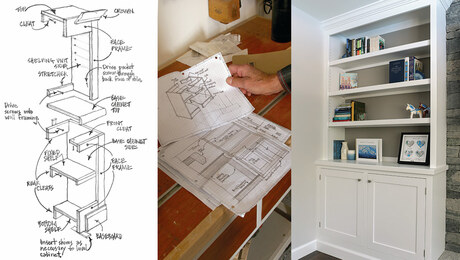Just finished reno of my 2 family and have moisture issue in bathroom. The bath is 7’2x 6′ with 8′ ceilings, 1 pc fiberglass tub plaster walls 80 CFM fan with less than 7′ duct to outside shed roof with roof vent. All walls insulated as well as ceiling. Been using 1 month with 4 people showering daily and already have moisture/ paint problem. The paint around where the top shower flange is peeled all the way down to plaster. The bath has 2 coats of flat ceiling paint as primer and 2 coats of Behr kitchen and bath finish.
After talking to some painters i scraped down and roughed with sandpaper and primed with oil primer and let cure several days. Ready to finish but wonder if it will happen again.
I figured the fan was big enough and I also have an 32 x 46 double hung window for warm weather venting.
Did I miss something or is it just HD















Replies
Well, let's back up a bit, and look at what's happening.
Hot air holds more water than cold air. Pass warm, wet air past something cold, and the water will condense out.
One approach is to 'pump' the hot air outside, where the moisture can condense harmlessly. For this to happen, you need two things - a clear path out (usually provided), AND a supply of fresh air to replace the air that you removed. If the fan is not moving enough air, it's very possible that it needs a better supply of fresh air into the room. This airflow needs to continue until all the wet air has been removed - not just while you're in the room.
A related part of the problem is the 'wetness' of the fresh air. Dry air will pick up more moisture than air that is already carrying water.. In Nevada, this is not a problem; in Louisiana, it is.
Finally, you can reduce moisture condensation by heating the surfaces where the water tends to condense. Radiant heat - that is, a heat lamp bulb - is a pretty effective way to do this. Feels pretty good while you shower, too!
Sometimes, though, the best approach is to give up, accept the problem, and use materials that are not bothered by water. Tile, FRP, even Formica are all very moisture resistant materials. Just make sure you give the water a place to drain.
New plaster needs about 30 days cure time before painting or it can cause that kind of thing.
Welcome to the
Taunton University of Knowledge FHB Campus at Breaktime.
where ...
Excellence is its own reward!
If you primed with an alkyd primer designed for cured plaster surfaces like SW ProBlock or even SW Masonry Primer. or BM All-purpose Alkyd you should be OK.
The issue with plaster is alkalinity. Alkalinity is problematic for paints including primers if they are not formulated for alkaline surfaces or if surfaces are not properly prepared. PVA primer is a good example of a poor choice for plaster for just this reason. After the 30 day plaster cure, it can be wiped with a cloth dampened in 1 pint white vinegar water to 1 gallon of water to help neutralize it before priming.
Jeff
Here are some related industry guides:
http://literature.usg.com/pdf/PM15.pdf
http://www.paintquality.com/ppp/interior/plaster2.html
http://www.sherwin-williams.com/pro/problem/surface_prep/index.jsp
http://www.benjaminmoore.com/bmpsweb/portals/bmps.portal?_nfpb=true&_windowLabel=contentrenderer_1_3&contentrenderer_1_3_actionOverride=%2Fbm%2Fcms%2FContentRenderer%2FrenderContent&contentrenderer_1_3currentNodeUUID=%2FBEA+Repository%2F42054&contentrenderer_1_3NodeUUID=%2FBEA+Repository%2F42034&_pageLabel=fh_findproducts#recommended_for
not only alkalinity, but new plaster is still offgassing moisture of its own
Welcome to the Taunton University of Knowledge FHB Campus at Breaktime. where ... Excellence is its own reward!
Add a timer to the fan so it still runs after you have left the room and make sure replacement air can get into the room. Ensure the fan box is sealed to the ceiling and all holes in the box are sealed. Duct should also go directly to the outside.
When you say the paint is peeling around top shower flange, do you mean the round cover (escuchon?) around the bent pipe that the shower head is attached to?
If this is the case, it sounds like steam on the wall is dripping into the hole for the shower pipe and keeping the backer wet for the paint to fail.
You need to dry this area thoroughly, maybe even about a month, before you repair and repaint. Cover the shower head pipe with plastic and tape the top so the condensing steam can't drain into this hole. The tape may damage the wall and you can try blue tape but it may need replacing everyday. After a month, scrape off the paint around this area and repair with quick setting compound. I heard this is more resistant to moisture. Then prime and paint.
After you screw in the pipe, fill the gap with silicon caulk. When placing the escuchon, put a thick bead of same caulk on inside of the escuchon, but only the top half. Leave the bottom half as is so if any water gets in, it will have space to drain. This applies to faucet and spout holes as well. Faucet cover may have a foam gasket but put some bead of caulk on this as well.
If there is another renovation, consider using durock or hardibacker and taking the tile above the shower head pipe, but use the caulk precaution anyway. Good luck.
Simplest question. Is the fan being used and if so is it being left on long enough to remove all the moisture?
I've seen some install with a timer instead of a normal switch. this keeps the fan on for awhile after the person is done showering.
Edited 5/2/2008 3:53 pm ET by MSA1